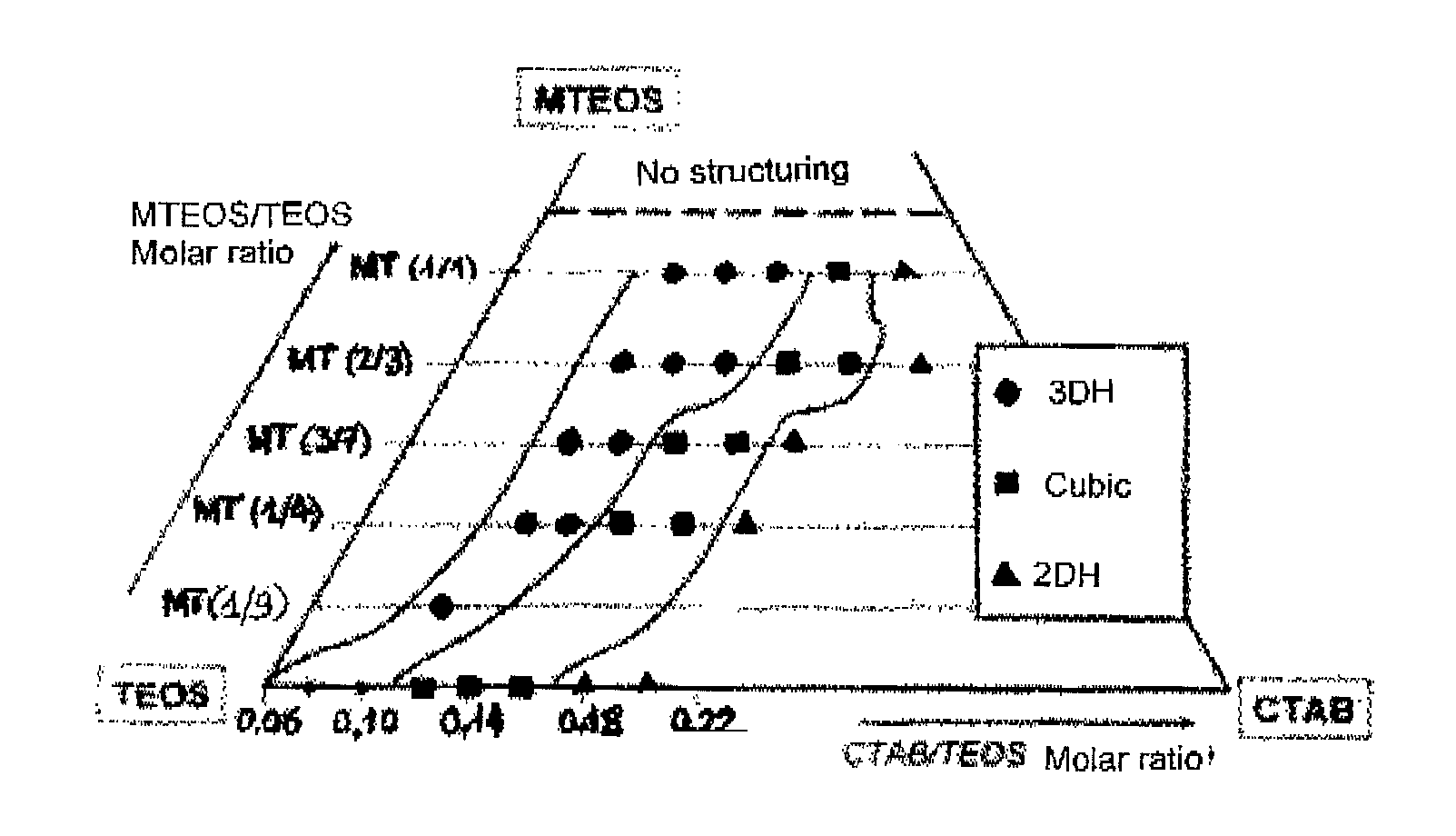Method of producing a substrate which is coated with a mesoporous layer and use thereof in ophthalmic optics
a technology of mesoporous layer and substrate, which is applied in the field of substrate production method, can solve the problems of low stability in the presence of an atmosphere with a high degree of moisture, the film obtained according to the technique of this patent has proved to be changing rapidly, and the initial properties are modified
- Summary
- Abstract
- Description
- Claims
- Application Information
AI Technical Summary
Benefits of technology
Problems solved by technology
Method used
Image
Examples
example 1
TEOS-Based Mesoporous Layers Modified by Post-Synthesis Grafting
[0178]1. a. Elaboration of the Precursor Sol
[0179]Reagents
TEOS: Si(OC2H5)4
Absolute ethanol
Diluted hydrochloric acid (pH=1.25)
CTAB (surfactant): C16H33N+(CH3)3, Br−
[0180]Preparation of the Inorganic Sol
[0181]The TEOS is hydrolysed then partially condensed by heating for 1 hour at 60° C. in an ethanol / dilute hydrochloric acid medium, in a flask equipped with a cooler. The molar ratios are as follows:
[0182]
TEOSEthanolH2O (1)13.85(1) water at pH 1.25 (acidified with hydrochloric acid)
[0183]Preparation of a Surfactant Solution in Ethanol and Mixing with the Inorganic Sol
[0184]The CTAB is dissolved in ethanol by passing ultrasound waves through it for a few seconds. The inorganic sol is added once it has cooled. This step is carried out such that in the final mixture the molar ratio CTAB / Si is 0.10. The volume of ethanol used to dissolve the CTAB is equal to the volume of sol added.
[0185]1. b. Depositing the Precursor Sol
[01...
example 2
TEOS-Based Mesoporous Layers Modified During Synthesis and by Post-Synthesis Grafting
[0214]The basic substrates are the same as in Example 1.
[0215]2. a. Elaboration of the Precursor Sol
[0216]The silica sol produced in Example 1 is comprised of small polymer clusters of partially condensed silicon dioxide, containing a large quantity of silanol functions. The latter disappear when the MTEOS is introduced into the mixture. Thus we designed this synthesis such that the set {silicon dioxide polymer cluster+MTEOS} remains sufficiently hydrophilic to not disturb the hydrophilic-hydrophobic balance of the system (because the polymerised MTEOS is hydrophobic, unlike the hydrolysed uncondensed MTEOS).
[0217]In the synthesis disclosed below, the molar ratios CTAB / TEOS and MTEOS / TEOS are 0.16 and 2 / 3 respectively.
[0218]Preparation of the Silica Sol
[0219]The TEOS is hydrolysed and condensed according to the method described in Example 1. The sol obtained is cooled to 0° C. in an ice bath.
[0220]P...
example 3
[0244]Introducing a reactive agent with a hydrophobic group concomitantly with the elimination of the pore forming agent (after the depositing step b): grafting trimethylmethoxysilane (CH3)3SiOCH3 (TMMOS) into the methylethylketone CH3—CO—CH2CH3 (MEK); simultaneous elimination of the CTAB.
[0245]This example describes a grafting method of a hydrophobic agent that is introduced at the time of step (d).
[0246]Steps a), b) and c) from Example 1 are reproduced identically.
[0247]A film made of mesoporous silicon dioxide with a 3d hexagonal structure, structured by the CTAB obtained after steps a) and b) (about 4 cm2, initial thickness 340 nm) is plunged into 125 mL of methyl ethyl ketone MEK. This solvent is preferred to acetone because its boiling point is higher (80° C. compared with 56° C.), which makes it possible to speed up the grafting reaction. 1 mL of TMMOS is added (greatly in excess compared with the quantity of silanols to graft) and the whole is heated to reflux. The eliminati...
PUM
| Property | Measurement | Unit |
|---|---|---|
| Temperature | aaaaa | aaaaa |
| Temperature | aaaaa | aaaaa |
| Time | aaaaa | aaaaa |
Abstract
Description
Claims
Application Information
 Login to View More
Login to View More - R&D
- Intellectual Property
- Life Sciences
- Materials
- Tech Scout
- Unparalleled Data Quality
- Higher Quality Content
- 60% Fewer Hallucinations
Browse by: Latest US Patents, China's latest patents, Technical Efficacy Thesaurus, Application Domain, Technology Topic, Popular Technical Reports.
© 2025 PatSnap. All rights reserved.Legal|Privacy policy|Modern Slavery Act Transparency Statement|Sitemap|About US| Contact US: help@patsnap.com



